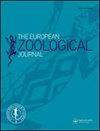赤足扁豆(扁豆科,两栖类)耐受极度缺氧
IF 1.4
4区 生物学
Q2 ZOOLOGY
引用次数: 1
摘要
两栖动物被认为对缺氧敏感,就这种能力而言,它们介于对缺氧耐受性差的哺乳动物和对可变氧利用率具有良好耐受性的一些海龟和鱼类之间。然而,我们发现帕拉斯的锹足,Pelobates vespertinus(帕拉斯,1771),一种欧亚无uran穴居两栖动物,能够在严酷的缺氧条件下过冬。这个物种可以忍受比正常大气浓度(约2%)低近10倍的长期生命氧浓度。致死氧浓度约为1%(个体差异为0.6 ~ 1.8%),比大气浓度低20倍。赤足在土壤中越冬半年以上,贮藏器官(脂肪体和肝脏)体积小,脂质和糖原含量低,在3°С的常氧条件下消耗率低。在缺氧条件下,脂质消耗停止,糖原消耗增加,表明从有氧代谢到无氧代谢的转变。由于冬季低温和糖酵解的激活而导致的代谢率降低的累积效应使得帕拉斯的锹足被认为是研究中最耐缺氧的穴居两栖动物之一。本文章由计算机程序翻译,如有差异,请以英文原文为准。
Pallas’ spadefoot Pelobates vespertinus (Pelobatidae, Amphibia) tolerates extreme hypoxia
Abstract Amphibians are believed to be sensitive to hypoxia, and in terms of this ability, they are between mammals with poor toleranсе to hypoxia and some turtles and fish with good tolerance to variable oxygen availability. However, we found that the Pallas’ spadefoot, Pelobates vespertinus (Pallas, 1771), a Eurasian anuran burrowing amphibian species, is capable of surviving in harsh hypoxia during wintering. This species can tolerate over long-term vital oxygen concentration of almost 10 times lower than the normal atmospheric air concentration (about 2%). The lethal oxygen concentration was about 1% (from 0.6 to 1.8% for different individuals), i.e. 20 times lower than the atmospheric concentration. The Pallas’ spadefoots overwinters in soils for more than half a year, having small sizes of storage organs (fat bodies and liver) and low content of lipids and glycogen in them, which are consumed at a low rate in normoxia at 3°С. Under hypoxic conditions, lipid consumption stops, and glycogen consumption increases, indicating a shift from aerobic to anaerobic metabolism. The cumulative effect of the reduced metabolic rate due to low wintering temperatures and the activation of glycolysis allows the Pallas’s spadefoot to be considered as one of the most hypoxia-resistant burrowing amphibian species studied.
求助全文
通过发布文献求助,成功后即可免费获取论文全文。
去求助
来源期刊

European Zoological Journal
Agricultural and Biological Sciences-Animal Science and Zoology
CiteScore
3.10
自引率
5.60%
发文量
80
审稿时长
30 weeks
期刊介绍:
The European Zoological Journal (previously Italian Journal of Zoology) is an open access journal devoted to the study of all aspects of basic, comparative and applied protozoan and animal biology at molecular, cellular, tissue, organ, organismal, population, and community-ecosystem level. Papers covering multiple levels of organization and integrative approaches to study animal form, function, development, ecology, evolution and systematics are welcome. First established in 1930 under the name of Il Bollettino di Zoologia, the journal now has an international focus, reflected through its global editorial board, and wide author and readership.
 求助内容:
求助内容: 应助结果提醒方式:
应助结果提醒方式:


